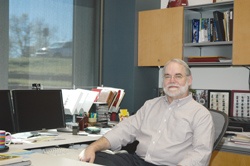UA Program Replicates Industry Workplace in Academic Environment
by October 29, 2012 12:00 am 96 views

Ken Vickers was an off-and-on recruiter for his then-employer, Texas Instruments Inc., in 1997 when he brought up a point he’d made many times before to University of Arkansas professor Greg Salamo.
Vickers, a Batesville native and UA alum, longed to find top-flight science and engineering students who also possessed some amount of business acumen and management skills. Vickers laughed recently when recalling Salamo’s response.
“Either get up here and do it or quit complaining about it,” Salamo told Vickers.
And to a degree, that’s how the UA’s microelectronics-photonics graduate program was born. Now housed in the UA’s cutting-edge Nanoscale Material Science and Engineering Building, the program is in its 15th year and boasts more than 140 graduates — 105 with master’s degrees and 38 with Ph.D.s.
The stand-alone program reports directly to the UA Graduate School rather than a traditional department or college. Its stated mission is “to expand a student’s knowledge beyond the boundaries of traditional departmental-based graduate programs.”
Much of that is done by requiring each student to complete 10 hours of courses in technology management and research commercialization. These hours are in addition to the 24 hours required for a typical master’s degree, and result in an increased workload for those in the program.
“We expect a lot more from our students,” said Vickers, who has been the program’s director from the get-go.
The program currently has an enrollment of 64, and Vickers said each student will come out with a rock-solid background in micro to nanoscale materials, processes and devices. What will separate his program’s graduates, however, is they will “also realize many of the business aspects of the technology they’re hired to produce,” Vicker said.
“They think like managers … so it helps them provide management with the right kind of information. It gives them perspective you just don’t get with a traditional science or engineering program.”
